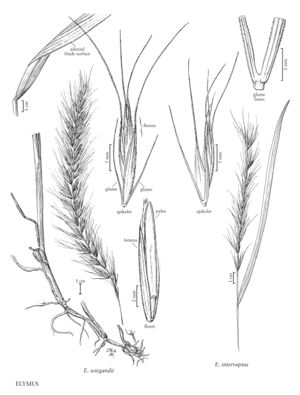Difference between revisions of "Elymus wiegandii"
FNA>Volume Importer |
FNA>Volume Importer |
||
| Line 20: | Line 20: | ||
-->{{Treatment/Body | -->{{Treatment/Body | ||
|distribution=Maine;N.H.;N.J.;Minn.;Mass.;N.B.;Ont.;Que.;Sask.;Conn.;Vt.;Mich.;Wis.;N.Y.;Pa.;N.Dak.;S.Dak.;Wyo.;Iowa;Ky. | |distribution=Maine;N.H.;N.J.;Minn.;Mass.;N.B.;Ont.;Que.;Sask.;Conn.;Vt.;Mich.;Wis.;N.Y.;Pa.;N.Dak.;S.Dak.;Wyo.;Iowa;Ky. | ||
| − | |discussion=<p>Elymus wiegandii grows in moist or damp, rich, alluvial soil, especially on sandy river terraces and in woods and thickets, primarily from Saskatchewan through much of the Great Lakes region to Nova Scotia and Connecticut. It has abnormal neocentric chromosomes with meiotic irregularities that appear to limit the fertility of its hybrids, and even some crosses within the species (Vilkomerson 1950). It may be derived from hybrids between E. canadensis (p. 303) and perhaps E. riparius (p. 302). The latter species is similar to E. wiegandii and overlaps with it in range and habitat within the Great Lakes region, where there are a few plants that appear to be hybrids between the two. Plants with scabrous-hirtellous or glabrous lemmas (E. wiegandii f. calvescens Fernald) are known from Maine and New Hampshire.</p><!-- | + | |discussion=<p><i>Elymus wiegandii</i> grows in moist or damp, rich, alluvial soil, especially on sandy river terraces and in woods and thickets, primarily from Saskatchewan through much of the Great Lakes region to Nova Scotia and Connecticut. It has abnormal neocentric chromosomes with meiotic irregularities that appear to limit the fertility of its hybrids, and even some crosses within the species (Vilkomerson 1950). It may be derived from hybrids between <i>E. canadensis</i> (p. 303) and perhaps <i>E. riparius</i> (p. 302). The latter species is similar to <i>E. wiegandii</i> and overlaps with it in range and habitat within the Great Lakes region, where there are a few plants that appear to be hybrids between the two. Plants with scabrous-hirtellous or glabrous lemmas (<i>E. wiegandii</i> f. calvescens Fernald) are known from Maine and New Hampshire.</p><!-- |
| − | --><p>Elymus wiegandii is often confused with sympatric E. canadensis and E. diversiglumis (p. 316), but it has a distinctive robust, broad-leaved habit. It is intermediate between the two in spike density and glume development. Occasional plants with glabrous leaves and less pendent spikes suggest introgression from E. canadensis, but artificial crosses produced no fertile Fj plants (Church 1958).</p> | + | --><p><i>Elymus wiegandii</i> is often confused with sympatric <i>E. canadensis</i> and <i>E. diversiglumis</i> (p. 316), but it has a distinctive robust, broad-leaved habit. It is intermediate between the two in spike density and glume development. Occasional plants with glabrous leaves and less pendent spikes suggest introgression from <i>E. canadensis</i>, but artificial crosses produced no fertile Fj plants (Church 1958).</p> |
|tables= | |tables= | ||
|references= | |references= | ||
| Line 42: | Line 42: | ||
|publication year= | |publication year= | ||
|special status= | |special status= | ||
| − | |source xml=https://jpend@bitbucket.org/aafc-mbb/fna-data-curation.git/src/ | + | |source xml=https://jpend@bitbucket.org/aafc-mbb/fna-data-curation.git/src/8f726806613d60c220dc4493de13607dd3150896/coarse_grained_fna_xml/V24/V24_430.xml |
|subfamily=Poaceae subfam. Pooideae | |subfamily=Poaceae subfam. Pooideae | ||
|tribe=Poaceae tribe Triticeae | |tribe=Poaceae tribe Triticeae | ||
Revision as of 16:19, 18 September 2019
Plants cespitose, not rhizomatous, somewhat glaucous. Culms 100-180(220) cm, erect; nodes 9-16, mostly concealed by the leaf sheaths, glabrous. Leaves evenly distributed; sheaths usually glabrous, occasionally villous, often reddish brown; auricles 1-3 mm, brown; ligules to 1 mm; blades (8)10-20(24) mm wide, flat, lax, dark green, adaxial surfaces usually thinly pilose, with weakly spreading hairs on the veins at least near the margins, sometimes villous or glabrous. Spikes 10-30 cm long, 3-5 cm wide, pendent, the bases often barely exserted, with 2 spikelets per node; internodes 5-8(12) mm long, 0.2-0.3 mm thick at the thinnest sections, usually pubescent beneath the spikelets. Spikelets 12-20 mm, divergent, with (3)4-6(7) florets, lowest florets functional; disarticulation above the glumes and beneath each floret. Glumes equal or subequal, 12-30 mm including the often undif¬ferentiated awns, the basal 0.5-1 mm subterete and slightly indurate, glume bodies 7-12 mm long, (0.2)0.4-0.9(1.1) mm wide, linear-setiform, entire, widening or parallel-sided above the base, 1-3(5)-veined, glabrous, hispidulous or villous, especially near the margins, margins firm, awns (5)8-15(18) mm, straight or flexuous; lemmas 10-15 mm, usually uniformly appressed-villous, rarely scabrous-hirtellous or glabrous, awns 15-25(30) mm, moderately to strongly outcurving; paleas 9-14 mm, narrowly truncate, minutely bidentate; anthers 2-3.5 mm. Anthesis from mid-July to early August. 2n = 28.
Distribution
Maine, N.H., N.J., Minn., Mass., N.B., Ont., Que., Sask., Conn., Vt., Mich., Wis., N.Y., Pa., N.Dak., S.Dak., Wyo., Iowa, Ky.
Discussion
Elymus wiegandii grows in moist or damp, rich, alluvial soil, especially on sandy river terraces and in woods and thickets, primarily from Saskatchewan through much of the Great Lakes region to Nova Scotia and Connecticut. It has abnormal neocentric chromosomes with meiotic irregularities that appear to limit the fertility of its hybrids, and even some crosses within the species (Vilkomerson 1950). It may be derived from hybrids between E. canadensis (p. 303) and perhaps E. riparius (p. 302). The latter species is similar to E. wiegandii and overlaps with it in range and habitat within the Great Lakes region, where there are a few plants that appear to be hybrids between the two. Plants with scabrous-hirtellous or glabrous lemmas (E. wiegandii f. calvescens Fernald) are known from Maine and New Hampshire.
Elymus wiegandii is often confused with sympatric E. canadensis and E. diversiglumis (p. 316), but it has a distinctive robust, broad-leaved habit. It is intermediate between the two in spike density and glume development. Occasional plants with glabrous leaves and less pendent spikes suggest introgression from E. canadensis, but artificial crosses produced no fertile Fj plants (Church 1958).
Selected References
None.
